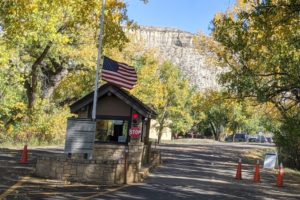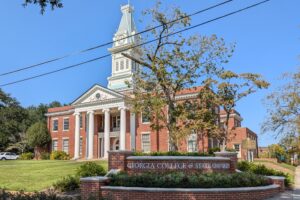In case you haven’t already read about the Holland Bow Mill in the previous post, you may want to do so before reading this post because it provides so much of the background for what we’re going to see as we tour the factory and see the bowls being made. In this post we’ll also look at the town of Holland today and how the town got started in the mid-1800s. A view of the Big Red lighthouse finishes off this post.

early history

- 1906 – Louis Fuller founded the Fuller Bowl Mill in North Muskegon, just north of where we are. The company developed the process of making nested bowls, which meant turning a series of bowls from 1 block of wood.
- 1926 – Chester Van Tongeren opened his Dutch Novelty Shop near downtown Holland that later became known as the Wooden Shoe Factory.
- 1946 – Louis Fuller’s sons, Charles and Victor, became 2nd generation owners of bowl mill that produced 300-400 bowls per week ranging in sizes from 6″ to 16″.
- 1962 – The Wooden Shoe Factory moved to a new location and as it grew, became one of the most popular tourist attractions in Holland. In 1964, they started selling wooden bowls from the Fuller Bowl Mill in their gift and souvenir shops.
later history

- 1987 – The Wooden Shoe Factory bought the Bowl Mill from the Fuller family and continued producing bowls in a building behind the factory until 1999. Grandson of Chester Von Tongersen, Dave Gier, was now the owner of the Wooden Shoe Factory and the Bowl Mill. He decided to close the Shoe side of the business to concentrate on producing wooden bowls. The new company is renamed Holland Bowl Mill.
- 2001 – The new company moved to its current location and customized the building for the bowl making process, including the new hydraulic lathes that they designed and built. As the company grew over the next few years, they could produce 800-1000 bowls a week.
- 2017 – Dave’s son, Kory Gier, takes on a more active role in the business and will become the 4th generation owner. Daughter Krista Chalifour joined the business in 2019. The Bowl Mill returns to the tourism industry by offering free tours and opening their retail store.
some finished products

the process of making bowls
We talked a little about the process of making the nesting bowls in the previous post, but here are pictures of what the process looks like. If you’d like to know more about this process, you can go to their website, www.hollandbowlmill.com. Under About Us, you can link on the video describing the process; it was produced in 2007 for the Discovery and Science Channel. You can also search for the video on YouTube.

The dampness of the timber helps lubricate the cutting tools.


In front of his working space on the right are the blocks before they are cut and after they have been hollowed out for the bowls.















showroom
The showroom highlights the different types of wood the mill uses for their bowls and other wood products.





(Sorry that the beech wood sign is partially covered; I didn’t realize the problem with the picture until I started working on the blog.)





What’s your favorite wood? If you’d like to order a bowl or other wooden item, you can do so at www.hollandbowlmill.com.
family business




visitor friendly
As we spent time downtown for meals and such, we noticed that we never had to pay for parking. We asked about this at the visitors center and were told that a wealthy woman paid for all of the parking for all time so visitors would feel welcome. How nice.
We also were told about the snowmelt system in place during the winter. Since 1988, residents and visitors haven’t had to deal with snow or ice on the streets and sidewalks in downtown Holland. Waste heat from power generation is captured to heat water that circulates through 190 miles of tubing laid underneath the pavement and sidewalks. The system pumps over 4700 gallons of water per minute at 90 degrees and can melt about 1″ of snow an hour at 20 degrees Fahrenheit, even with winds of 10 mph.
The snowmelt system is a closed system, which means the same water is circulated over and over. Prior to 2016, the system pulled water from Lake Macatawa. Non-potable water is used, reducing the sediment and wear on valves. Added benefits include no salting, plowing, slipping, or sliding. The system keeps expanding to include more parts of town so that now about 600,000 square feet of heated sidewalks and streets are kept clear. It is the largest publicly-owned snowmelt system in North America. Good job, Holland!
Big Red Lighthouse
Michigan’s most photographed lighthouse, Holland’s well loved “Big Red” is not to be missed, even though we almost did because the day was so cold and windy.


When looking for a location for his Netherlands emigrant followers in 1847, the Reverend A.C. Van Raalte was attracted by the potential of using Black Lake (Lake Macatawa) as a harbor so the emigrants would have an agricultural port.

On July 1, 1859, the small steamboat Huron made it into port. Just 7 years late the U.S. government established the harbor’s first lifesaving station. By 1899, the channel had been relocated and the harbor work completed, spurring on business and resort expansion. In 1900, over 1095 schooners, steamers, and barges used the harbor.
the lighthouse
The 1st lighthouse built at this site was a small, square wooden structure built in 1872. In 1880 the lighthouse service installed a new light on top of a metal pole in a protective cage. The oil lantern was lowered by pulleys for service. At the turn of the century, a steel tower was built for the light, and in 1907 the present structure was erected.

Here are some more views of Lake Michigan from left to right.



After seeing Holland as it is today, we’ll go next to a display of Dutch costumes and learn some more about the Dutch in prior years.




